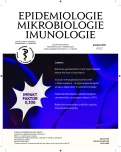Bacterial contamination of the indoor air in a transplant unit
Authors:
Matoušková Ivanka; Holý Ondřej
Authors place of work:
Ústav preventivního lékařství, Lékařská fakulta Univerzity Palackého v Olomouci
Published in the journal:
Epidemiol. Mikrobiol. Imunol. 62, 2013, č. 4, s. 153-159
Summary
For one year (August 2010 to July 2011), microbial contamination of the indoor air in the Transplant Unit of the Haemato-Oncology Clinic, Olomouc University Hospital was monitored monthly. Twenty sampling sites were singled out and a total of 240 indoor air samples were collected. An MAS-100 air sampler (Merck, GER) was used, air flow rate of 100 liters per minute, 1 minute. The measured values of indoor air temperature were stable. The relative air humidity ranged from 17% to 68%. The highest average value of microbial air contamination was found in the "staff entry room" (1170 CFU/m3). The lowest microbial air contamination (150–250 CFU/m3) was measured in the patient isolation units. The most frequently isolated bacterial strains were coagulase-negative staphylococci (94.3%), followed by Micrococcus spp. (67%) and Bacillus subtilis (11%). It can be assumed that the source of these airborne bacterial strains are both patients and medical staff. They are classified as opportunistic pathogens and as such can cause hospital infections among haemato-oncology patients.
Keywords:
hospital environment – clean rooms – haemato-oncology patients – coagulase-negative staphylococci – risk of infection
Zdroje
1. FED-STD-209, Airborne Particulate Cleanliness Classes in Cleanrooms and Cleanzones. September 11,1992.
2. Technická zpráva – Projekt stavby (transfuzní stanice, hematologie a rehabilitace). PS 01 – Strojovny a rozvody vzduchotechniky. Zařízení VZT. IDOP Olomouc. 1994, 124 s.
3. Kowalski, W. Hospital Airborne Infection Control. 1th Ed. Boca Raton, London, New York: CRC Press, 2012, p. 349.
4. La Rosa, G., Fratini, M., Libera, D., Libera, S. D., Iaconelli, M. et al. Viral infections acquired indoors through airborne, droplet or contact transmission. Ann. Ist. Super. Sanita., 2013, 49, 2, p. 124–132.
5. Krogulski, A., Szczotko, M. Microbiological quality of hospital indoor air. Determinant factors for microbial concentration in air of operating theatres. Rocz. Panstw. Zakl. Hig., 2011, 62, 1, p. 109–113.
6. Crimi, P., Valgiusti, M., Macrina, G., Grieco, A., Massone, L. et al. Evaluation of microbial contamination of air in two haematology departments equipped with ventilation systems with different filtration devices. J. Prev. Med. Hyg., 2009, 50, 1, p. 33–36.
7. Matoušková, I., Raida, L., Holý, O. Výskyt gramnegativních nefermentujících bakterií v prostředí transplantační jednotky Hemato-onkologické kliniky FN Olomouc. Epidemiol. Mikrobiol. Imunol., 2012, 61, 4, p. 110–115.
8. Holý, O., Matoušková, I., Raida, L. Výskyt gramnegativních bakterií v prostředí transplantační jednotky Hemato-onkologické kliniky FN Olomouc. Epidemiol. Mikrobiol. Imunol., 2012, 61, 4, p. 103–109.
9. Milton, D. K., Feldman, H. A., Neuberg, D. S., Bruckner, R. J. et al. Enviromental endotoxin measurement: the Kinetic Limulus Assay with Resistant-parallel-line Estimation. Environ. Res., 1992, 57, p. 212–230.
10. Möller, W., Heimbeck, I., Hofer, T. P. J., Saba, G. K. et al. Differential Inflammatory Response to Inhaled Lipopolysaccharide Targeted Either to the Airways or the Alveoli in Man. PLoS ONE. 2012, 7(4), e33505. doi:10.1371/journal.pone.0033505.
11. Otter, J. A., Yezli, S., French , G. L. The role played by contaminated surface in the transmission of nosocomial pathogens. Infect. Control. Hosp. Epidemiol., 2011, 32, 7, p. 687–699.
12. Knochen, H., Hübner, N. O., Below, H., Assadian, O. et al. Influence of floor disinfection on microbial and particulate burden measured under low turbulance air flow in ophthalmonological operation theatres. Klin. Monbl. Augenheilkd., 2010, 227, 11, p. 871–878.
13. Roongpoovapatr, P., Suankratay, C. Causative pathogens of fever in neutropenic patients at King Chulalongkorn Memorial Hospital. J. Med. Assoc.Thai., 2010, 93, 7, p. 776–783.
14. Bonetta, S., Bonetta, S., Mosso, S., Sampo, S. et al. Assessment of microbiological indoor air quality in an Italian office building equipped with an HAVC system. Environ. Monit. Assess., 2010, 161, p. 473–483.
15. Boyce, J. M., Havill, N. L., Moore, B. A. Terminal decontamination of patient rooms using an automated mobile UV light unit. Infect. Control. Hosp. Epidemiol., 2011, 32, 8, p. 737–742.
16. Rutala, W. A., Gergen, M. F., Tande, B. M., Weber, D. J. Rapid hospital room decontamination using ultraviolet (UV) light with a nanostructured UV– reflective wall coating. Infect. Control. Hosp. Epidemiol., 2013, 34, 5, p. 527–529.
Štítky
Hygiena a epidemiologie Infekční lékařství MikrobiologieČlánek vyšel v časopise
Epidemiologie, mikrobiologie, imunologie

2013 Číslo 4
- Diagnostický algoritmus při podezření na syndrom periodické horečky
- Prokalcitonin: marker vhodný pro diagnostiku sepse i hodnocení antimikrobiální léčby
- Stillova choroba: vzácné a závažné systémové onemocnění
- Choroby jater v ordinaci praktického lékaře – význam jaterních testů
- Diagnostika virových hepatitid v kostce – zorientujte se (nejen) v sérologii
Nejčtenější v tomto čísle
- Epidemiologie infekčních nemocí
- Bakteriální kontaminace vnitřního vzduchu transplantační jednotky
- Molekulárněbiologické a epidemiologické charakteristiky viru planých neštovic (VZV)
- Prof. MUDr. Pavol Bakoss, DrSc. 80-ročný
